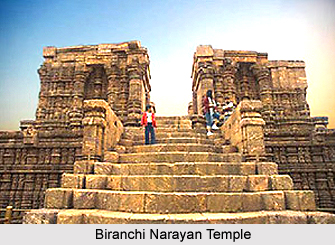 Biranchi Narayan Sun, an ancient Hindu shrine popularly known as `Wooden Konark` is located in the small town of Buguda in Ganjam District in the Indian state of Orissa. Revered as the abode of Viranchinarayana, it is the second Surya temple in the state after the renowned Konark Temple. This enchanting Surya temple is at a distance of 92 kms from Chhatrapur. Situated in Badadanda Sahi, the temple is on the south-west direction from Palasara Chowk.
Biranchi Narayan Sun, an ancient Hindu shrine popularly known as `Wooden Konark` is located in the small town of Buguda in Ganjam District in the Indian state of Orissa. Revered as the abode of Viranchinarayana, it is the second Surya temple in the state after the renowned Konark Temple. This enchanting Surya temple is at a distance of 92 kms from Chhatrapur. Situated in Badadanda Sahi, the temple is on the south-west direction from Palasara Chowk.
Legend of Biranchi Narayan Temple
According to a legend once King Srikara Bhanjadeva dreamt of Biranchi Narayan. The Lord told him that he remained in a neglected state at the foothills of the Malatigad Mountain located in the vicinity of Keshripalli of Ganjam District. He requested the king to recover his idol and install it in the newly built temple. The following day the king travelled to the said place where he met a farmer. The later stated that while he was sharpening his sword on a stone he saw blood oozing out from it. The king with the help of the farmer dug out the stone and discovered a statue of the Lord accompanied by seven horses and a wheel. The King as instructed established the idol in the temple. Later a stone image of Lord Surya was constructed in line of the original wood image.
Architecture of Biranchi Narayan Sun
The accolade for the construction of this magnificent Biranchi Narayan Sun is conferred upon King Srikara Bhanjadeva. It was under his patronage that the temple was erected in 1790 when the Bhanja Dynasty reined the area. Biranchi Narayan is the presiding deity of the shrine whose idol was recovered from the ruins at Maltigad. The religious edifice also known as Bruddha Khola Temple resembles a chariot being driven by seven horses with Arjuna donning the role of a chariot driver. A shrine within the temple complex enshrines an idol of two armed Lord Surya standing on his chariot erected on a platform. Forty-six intricately wooden carved pillars, thirty-two of shorter height and fourteen of taller height provide support to the roof of the temple. The temple chiefly built of materials like lime plaster and Khandolite stone faces the western side. Thus, the rays of the setting sun bathe the presiding deity of the shrine.
Biranchi Narayan Sun, throughout its length and breadth has been exquisitely embroidered with wood carvings and wall paintings illustrating parables from the Krishna Lila, Bali Vadha, Rama-Ravana, Ramayana, Setubandha Nirmana, Sita Vivaha and Mayamirga Vadha. Besides these, Lord Vishnu Kanchiabhijana`s 10 incarnations and fables associated with Jagannath and Puri`s King are also well illustrated through the paintings and carvings that augment the architectural brilliance of this pilgrimage centre.
Festivals of Biranchi Narayan Sun
Biranchi Narayan Sun celebrates several fair and fiesta with much vigour and enthusiasm. Festivals such as Makar Sankranti, Sambadasami, Magha Saptami, Ramnavami and Janmashtami are celebrated on a grand scale. Besides this, Ratha Saptami or Tila Saptami is celebrated in the month of Maagha and Samba Dashami is organised in the month of Pausha.
The temple is presently maintained by the Orissa State Archaeology and Endowment Department of the government of Orissa.





















